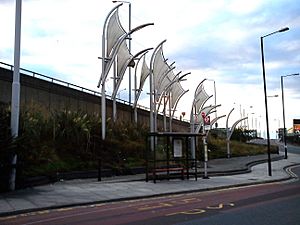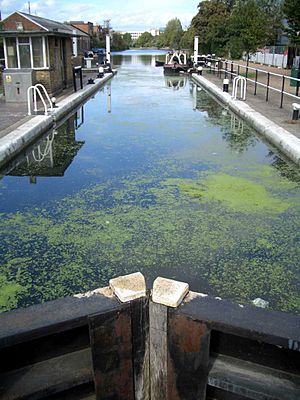Old Ford facts for kids
Quick facts for kids Old Ford |
|
|---|---|
 Sculptures in Old Ford |
|
| OS grid reference | TQ365835 |
| London borough | |
| Ceremonial county | Greater London |
| Region | |
| Country | England |
| Sovereign state | United Kingdom |
| Post town | LONDON |
| Postcode district | E3 |
| Dialling code | 020 |
| Police | Metropolitan |
| Fire | London |
| Ambulance | London |
| EU Parliament | London |
| UK Parliament |
|
| London Assembly | |
Old Ford is a part of Tower Hamlets in London. It gets its name from an old, natural crossing point called a "ford" across the River Lea. A ford is a shallow place in a river where people and animals can walk across.
Contents
A Look Back: The History of Old Ford
How Old Ford Grew Over Time
Old Ford started as a small group of houses and a mill near the ford. It was once part of a larger area called Stepney. Later, in 1719, Old Ford and Bow became their own separate area.
In the Victorian era, Old Ford grew very quickly. It became a busy outer suburb of London. Even though it grew, its local government was always linked with Bow.
Finding the Ancient River Crossing
Old maps from the Victorian times show where the old ford used to be. It was just south of the Northern Outfall Sewer, where the River Lea met the Hackney Brook. The river likely slowed down here, dropping mud and making it shallow enough to cross.
Digging deeper, archaeologists found that during Roman times, the ford was a bit further north. The Romans even added materials to make the ford better. At one point, they might have built a bridge over the Lea.
Evidence shows a Roman settlement in Old Ford from the 4th and 5th centuries. People lived along the road, and there were fields around them. Near the river, wooden buildings were found, including a large barn. Many cattle bones were also found, suggesting animals were butchered here for the London market. The River Lea was likely used to bring farm products and pottery to Roman London. Old Ford was where these goods were moved onto wagons to continue their journey.
Important Roads Using the Ford
Old Ford was the oldest crossing point on the River Lea that was closest to the sea. Back then, the Lea was a wide, fast-moving river. Its tidal part stretched as far as Hackney Wick.
Two main routes likely used this ford. Both continued through Essex, heading towards places like Colchester. Colchester was the first capital for the Romans when they took over Britain. The road from London Bridge to Colchester was one of the first paved Roman roads in Britain.
The routes that used the ford were:
- An old route from before the Romans. It followed what is now Oxford Street and Old Street. It went through Bethnal Green to Old Ford. From there, it crossed the marshes on a raised path called Wanstead Slip.
- The Roman Road that started at Aldgate in London. It went through Stratford and Chelmsford to Colchester and beyond. Today, much of this route is known as the A12 road.
Life After the Bridge Was Built
In 1110, Matilda, the wife of King Henry I, reportedly fell at the ford. She was on her way to Barking Abbey. After her fall, she ordered a special bow-shaped bridge with three arches to be built over the River Lea.
Even after the bridge was built at Bow, Old Ford remained important. The ford was still used a lot. However, the main population center moved to Bow during the Middle Ages. Old Ford had many watermills that made flour for the bakers of Stratforde-atte-Bow. This flour was then used to make bread for the City of London. Because Old Ford was a bit isolated, its residents were allowed to worship at the church in Stratforde-atte-Bow. This saved them the difficult trip to the main church in Stepney.
Today, a lock and weir are on the Lee Navigation near where the ford used to be. This is at the end of the 'Hackney Cut', an artificial channel built in the 1700s. The natural river channel joins back below the lock.

In June 1648, during the Wars of the Three Kingdoms, a group of Royalist soldiers fought a small battle near Bow Bridge. They defeated the local militia and stayed in Stratford for three days. They then went on to the Siege of Colchester. During their stay, they carefully guarded Bow Bridge and other local fords. This kept the River Lea safe from attacks from the City of London.
From Small Settlement to Busy District
Old Ford was mostly farmland and market gardens until the 1800s. Then, it became a busy part of London. Many houses were built for workers in new factories along the Lea and the Lee Navigation. New railways also brought more people.
In 1865, a large piece of land was bought for a gasworks. However, the Gas Light and Coke Company instead built what is now known as Fish Island. They gave its streets unique names and created a mix of homes and factories.
The North London Railway used to have a line through the area. There was a station called Old Ford railway station. This railway line was badly damaged during World War II and never reopened. The station buildings were taken down in the early 1960s.
Rebuilding Old Ford
After World War II, many areas needed rebuilding. The Lakeview Estate was built on a bombed site near Grove Road. It was designed by Berthold Lubetkin and opened in 1958.
Fish Island also suffered a lot of bombing during the war. Damaged homes were removed to make way for new factories and warehouses.
St Barnabas's, Bethnal Green church was also badly damaged. Its steeple was removed, and the church was rebuilt. The sculptor Don Potter created new statues of The Four Evangelists for the outside of the building.
Victoria Park became famous for its outdoor music festivals. These events often supported political causes in the 1970s and 80s. In 1978, the Rock Against Racism group held a concert there. It protested against far-right groups like the National Front. Famous bands like The Clash and Steel Pulse played at this concert. In 1975, the Baroness Burdett Coutts Drinking Fountain in the park was given special Grade II* listed status.
Old Ford Today
In 1986, the Greater London Council handed over control of Victoria Park to the London boroughs of Tower Hamlets and Hackney. Since 1994, Tower Hamlets has managed the park alone.
In 1991, St Paul's, Old Ford church had to close due to safety worries. But local people wanted the church to stay open and improve. They started the "A New Heart for Bow" project. They raised over £3 million from many different groups. The church was refurbished to serve the wider community as well as the church. Work started in 2003 and finished in 2004.
The St Barnabas Community Fete, also known as Bowstock, was an annual festival. It was held on Wennington Green in Mile End Park.
Fish Island has a long history as a home for artists. A study in 2009 found that it had one of the highest numbers of artists and designers in Europe. The Percy Dalton Peanut Factory was on Fish Island. Its buildings are now used as artist studios by SPACE. The TV show The Big Breakfast was broadcast live from a former lockkeeper's cottage on Fish Island from 1992 to 2002.
The Palm Tree is a local pub that was given Grade II listed status in 2015.
Exploring the Geography of Old Ford
The Bow Wharf is where the Regent's Canal meets the Hertford Union Canal. This meeting point is called the Hertford Union Junction. It is located between Mile End Lock and Old Ford Lock on the Regent's Canal.
Community Life in Old Ford
Local council services are found around Roman Road market. The local library, now called an Idea Store, is in Gladstone Place. There is also a community hall nearby. You can access council services at the Bow and North Poplar One Stop Shop.
The Percy Dalton Peanut Factory used to be on Fish Island. Its buildings are now used as artist studios by SPACE. SPACE also runs many community programs there.
The oldest model boat club in the world, the Victoria Model Steam Boat Club, was founded in Victoria Park on July 15, 1904. It is still active today. The club holds up to 17 regattas (boat races) each year on Sundays. They race traditional straight-running boats, as well as radio controlled boats and hydroplanes. The first regatta is usually on Easter Sunday, and the Steam Regatta is always on the first Sunday in July.
Education in Old Ford
Getting Around: Transport in Old Ford
Old Ford is served by several bus routes. Bus route 8 goes to Tottenham Court Road station and Bow Church. Other local bus routes include 277, 276, 339, 425, and 488, plus the D6. It is also connected to the London Night Bus network by the N8 and N277.
Old Ford does not have a London Underground station. However, it used to have railway stations. These were Old Ford railway station on the North London Railway and Coborn Road on the Great Eastern Main Line.
Old Ford is connected to the main National Road Network. Parnell Road and Tredegar Road link to the A12 (East Cross Route), which runs north/north east to south.
You can access the Hertford Union Canal by its tow-path. The National Cycle Route 1 also runs along this path. From Wick Road at St Marks Gate (Victoria Park), heading east leads to the Lee Navigation. Going north along the Lea leads to Hackney Marshes. Turning south along the Lea goes through Bow Locks into Bow Creek and then to the River Thames. There is a footbridge over the East Cross Route that connects Fish Island.



